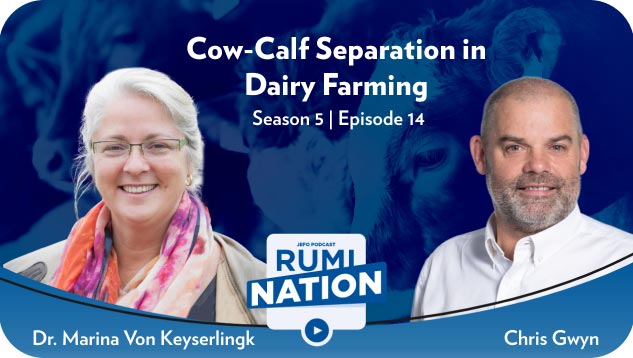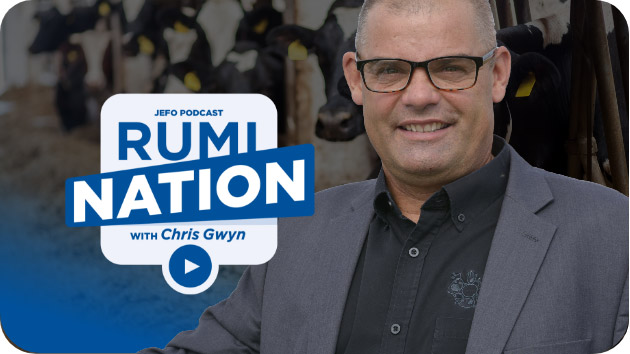RumiNation | S05 : E15
Demystifying De Novo Fatty Acid Synthesis
Brought to you by Jefo Nutrition
Share now!
Did you enjoy this episode?
Share now!
Our guest - Dr. Débora Santschi
Dr. Santschi has always shown a keen interest in everything that does not produce milk in the barn, such as calves, heifers, and dry cows. With a Bachelor’s Degree in Animal Science, a Master’s Degree in Dairy Cattle Nutrition from McGill University, and a PhD in Animal Science from Laval University, she joined Lactanet in 2010 as a nutrition and management expert and became Director of the R&D Team in 2019.
She is also an Adjunct professor in the departments of Animal Science of McGill, Laval, Manitoba, and the Faculty of Veterinary Medicine (University of Montreal). As on the CRAAQ Dairy Cattle Committee since 2009, she has been involved in the organization of the Dairy Cattle Symposium for several years.

Timestamps & Summary
Vicki Brisson (01:44)
As an introduction, can you explain what de novo fatty acid synthesis is?
Dr. Débora Santschi
To me, the fatty acids are basically if we would take that black box of fat, the milk fat test, open it up, and look at what’s inside of it. So, if we take, for example, a herd that is at 4% fat, if we open it up, we can see what makes up that 4% fat and see where those fatty acids come from. […]
The de novo fatty acids are one of those groups of fatty acids we find in the total fat. It represents, depending on the herds and the cows, roughly between 25-30% of the total fat. And those are the fatty acids that are synthesized in the mammary gland of the cow. […]
Vicki Brisson (04:00)
What impact does that milk fat composition have on the cow? And what are the periods when the fatty acid profile is more likely to vary?
Dr. Débora Santschi
I think it’s very interesting to look at it from a cow’s side and also from a herd’s side. So, if we take the cow example, a cow in very early lactation, we all know that she’s using her body reserves to compensate for that very high demand for milk production. In that case, a big chunk of her fat content will be preformed fatty acids. So, in very early lactation, we see roughly 50, or sometimes even slightly more, as a percentage of her fat being the preformed fatty acids. And in that case, the de novo will be very low and increase slowly over the first 45, 50, and 60 days of lactation. […]
If we look at it on a herd level, when we do some ration change, when the forage digestibility changes, but we don’t notice too much. All those little effects can also have an impact on the de novo content of the bulk tank sample. In that case, because bulk tank samples are often analyzed very frequently, then we can get a rapid insight into something that we might not have noticed on the farm level. […]
Vicki Brisson (05:46)
Knowing that the fatty acid profile of milk matters, what can we do to promote the production of de novo fatty acids?
Dr. Débora Santschi
The de novo fatty acids are the result of being produced in the mammary gland from rumen volatile fatty acids. So, everything that we can do to maximize rumen volatile fatty acids will have a positive impact. So, we often focus on the ration. So, of course, having a highly digestible ration, well balanced with all the nutrients that are required, is really important, but we need to keep in mind everything around it. […]
Vicki Brisson (07:33)
Can you expand on specific nutritional solutions that our listeners may want to consider?
Dr. Débora Santschi
The way we train our people, and I just want to mention, we have a lot of information that is available directly on the website as well to help understand and find solutions, because it’s going to be very herd specific. But when I look at a herd, I look at the fat test, and the protein test, because those are values we know and we handle very well. I look at the MUN value because to me, it’s important to look at the overall protein balance as well, and then I go and look at the fatty acid profiles. I always start with the de novo, then look at the mix, then look at the preform. That’s my way of addressing a report. […]
Vicki Brisson (10:01)
Beyond just the amount of de novo fatty acids produced is also the variation in fatty acid levels. So, what are the impacts of that variation in fatty acids and how can we address it?
Dr. Débora Santschi
Very good question. I think, again, there’s some information on the cow level, there’s some information on the bulk tank level. I like to work on the bulk tank level first because it’s every second day in our case, so it helps to get a very accurate and up-to-date overview. However, the downside is that it’s only on a farm level, it’s an average, and I have no idea of the distribution of it. […]
When there’s a lot of variation on the bulk tank, we see it a lot in the inconsistent feeding herds, in the herds that have a lot of changes in the ration, where the forage composition is not very constant. […]
Vicki Brisson (13:44)
Can you help us understand or explain the link between B vitamins and fatty acids?
Dr. Débora Santschi
To my knowledge, there hasn’t been too much specific research combining the two, I think that’s a very interesting area to explore. I think if we take one step back and look at the whole picture, rumen health, optimizing the bacterial populations we have in there, and making sure that this is all functioning well should also be reflected in the de novo synthesis. […]
Vicki Brisson (16:23)
Can you just expand a little on the tools that you have at Lactanet and that you offer your producers on how to monitor de novo fatty acids and how they can use that as a decision-making tool or to help them identify possible issues on the farm?
Dr. Débora Santschi
At Lactanet right now, back in 2020, we launched what we call PROFIlab. That’s our milk fatty acid monitoring tool, currently available in Quebec, and in some Atlantic provinces, at the bulk tank level for now. […]
We do have a prototype for the cow level. We tested it with some of our advisors, and some of our farmers. So, 2024 should see that prototype become a real tool, this time not only in Québec, but across the country. […]
Vicki Brisson (19:13)
Can you share your take-home messages? Maybe three or so for nutritionists, vets, and producers when they think de novo fatty acid synthesis in milk?
Dr. Débora Santschi
I’ll say the first one is that black box. I like to see it like that. We’re opening up the fat and understanding better what makes up that fat. So, get a deeper insight into your fat test, which is what we’re being paid for.
Second one, dare to use it. Just try. Just try something. Ask questions. Get the information you need to start working with it and try to have that value change. Try to cause an impact on that de novo value to make it move. And you’ll see how it can be powerful for your herds.
And the third one is, please, any suggestions, any ideas, any questions? You’re more than welcome to contact us because as I just said, I think that’s how we learn altogether and that’s how we can make it even better and then share that information back. […]







